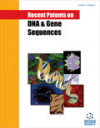- Home
- A-Z Publications
- Recent Patents on DNA & Gene Sequences (Discontinued)
- Previous Issues
- Volume 7, Issue 3, 2013
Recent Patents on DNA & Gene Sequences (Discontinued) - Volume 7, Issue 3, 2013
Volume 7, Issue 3, 2013
-
-
Recent Advances in Gene Therapy of Endometriosis
More LessAuthors: Anastasia N. Shubina, Anna A. Egorova, Vladislav S. Baranov and Anton V. KiselevEndometriosis is a gynecological disease that affects up to 10%-15% of all reproductive-age women worldwide. It is characterized by the presence of endometrial tissues outside the uterine cavity. Endometriosis is a complex disease; its pathogenesis includes altered steroid metabolism and immune system abnormalities such as inflammation, increased angiogenic activity in the peritoneal fluid and impaired recognition of ect Read More
-
-
-
Biotechnological Advances in Amaranths Species and their Future Outlook in Crop Improvement - A Review
More LessBy R.M. PandeyThe grain amaranths were important food crops for the ancient middle and South American civilization. The germplasm of amaranths also has not been well characterized from the point of view of its exploitation for improvement of amaranths in general, a grain amaranth in particular. Among all under exploited crops grain amaranth is the most suitable candidate to begin with. As it is one of the most important under exploited Read More
-
-
-
Energy Crops for Biofuel Feedstocks: Facts and Recent Patents on Genetic Manipulation to Improve Biofuel Crops
More LessBy Suresh KumarBurning fossil-fuels to meet the global energy requirements by human being has intensified the concerns of increasing concentrations of greenhouse gases. Therefore, serious efforts are required to develop nonfossil-based renewable energy sources. Plants are more efficient in utilizing solar energy to convert it into biomass which can be used as feedstocks for biofuel production. Hence with the increasing dema Read More
-
-
-
Patented Aptamers for C-Reactive Protein Detection: A Review About their Use in Clinical Diagnostics
More LessC-reactive protein (CRP) is a homopentameric oligoprotein composed of monomeric subunits that are about 21 kD each. The form of detectable native CRP in validated assays was developed in 2007 and from that time has been considered as an excellent biomarker for peripheral artery disease and/or atherosclerosis, as well as a cardiovascular disease marker for risk prediction. The improvements in the detection of CRP Read More
-
-
-
Patent Landscape for Biological Hydrogen Production
More LessAuthors: David B. Levin and Simona LubieniechiResearch and development of biological hydrogen production have expanded significantly in the past decade. Production of renewable hydrogen from agricultural, forestry, or other organic waste streams offers the possibility to contribute to hydrogen production capacity with no net, or at least with lower, greenhouse gas emissions. Significant improvements in the volumetric or molar yields of hydrogen production have be Read More
-
Most Read This Month
Article
content/journals/dnag
Journal
10
5
false
en


